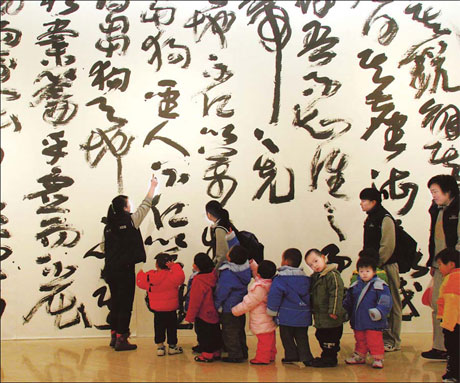Life and Leisure
Art for the masses
By Zhu Linyong (China Daily)
Updated: 2010-09-07 08:07
 |
Large Medium Small |
|
School kids visit an exhibition of calligraphy by Zhejiang artist Wang Dongling at the National Art Museum of China. Jiang Dong / China Daily |
The nation's museums, both public and private, are reaching out to the public in a way never before attempted with free admissions, special discounts and better services. Zhu Linyong reports
Hou Zhiqing, an art enthusiast from Inner Mongolia, spends most of her spare time wandering around Beijing's museums and galleries. The 32 year old, who makes a living by taking photograph for tourists to the Chinese capital, says she pays particular attention to information about lectures and interactive events for visitors. Recently, she attended a two-hour lecture and discussion on Chinese contemporary art at the National Art Museum of China, along with some 200 others.
The lecture was delivered by Zhu Qingsheng, an art professor with Peking University. Hou found it informative although she admits freely that she did not understand everything the professor said.
"But with such help one gains a better understanding of the exhibits," says the primary school dropout from the remote city of Fengzhen.
Recalling the 1990s, she says back then there were "no brochures, no audio guides, and no lecturers".
"Art museums and galleries are now becoming more accessible to visitors."
But the change only came after a barrage of criticisms from art educators, artists and public figures.
In 2007, outspoken artist and writer Chen Danqing said: "We have many art museums. But there is no art museum culture.
"Art museums should not function merely as an exhibiting space for a handful of artists. It should assume the more important role of serving the public," he noted.
Most art museums in China are actually art galleries financed by public funds, says curator Feng Boyi.
"What they are doing is holding commercially driven art exhibitions and selling tickets."
However, Fan Di'an, dean of the National Art Museum of China, points out that art museums are adjusting to the changing times and catching up with their Western counterparts.
Fan has been dean of the nation's most influential art museum, founded in 1962 with public funds, since December 2005.
He remembers that when he first took up the job, he spent two weeks strolling the exhibitions halls only to find that museum staff easily outnumbered the visitors.
That led him to initiate a series of measures which now place the museum alongside the National Center for the Performing Arts, Capital Museum, Forbidden City Concert Hall, and Capital Theatre, as a major cultural venue in Beijing.
It attracts more than 1 million visitors annually but Fan knows this number is still small.
While art museums offering free admission have seen a dramatic increase in attendance, not all are able to do so.
But most do have some sort of preferential policy, says Fan whose museum offers free admission to military personnel, disabled persons, people above 60 and under 17, and discounts to teachers and students.
However, Zhu Zhihong, deputy head of Hubei Art Museum, the first non-profit art museum at provincial level to allow visitors in for free in late 2008, says: "Free admission is just a minor step in attracting attention."
